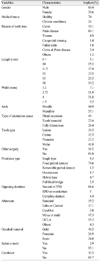Abstract
Purpose
This study was to compare the cumulative survival rate (CSR) of Brånemark machined surface implants and TiUnite™ imlants and to analyze association
between risk factors and the CSR of the implants.
Materials and methods
A retrospective study design was used to collect long-term follow-up clinical data from dental records of 156 patients treated with 541 Brånemark machined and TiUnite™ implants at Korea University Guro hospital in South Korea from 1993 through 2008. Machined implant and TiUnite™ implant were compared by CSR. Exposure variables such as gender, systemic disease, location, implant length, diameter, prosthesis type, opposing occlusion type, date of implant placement, type of edentulous space, abutment type, existence of splinting with natural teeth, and existence of cantilever were collected. Life table analysis was undertaken to examine the CSR. Cox regression method was conducted to assess the association between potential risk factors and overall CSR (α=.05).
Results
Patient ages ranged from 16 to 75 years old (mean age, 51 years old). Implants were more frequently placed in men than women (94 men versus 63 women). Since 1993, 264 Brånemark machined implants were inserted in 79 patients and since 2001, 277 TiUnite™ implants were inserted in 77 patients. A total survival rate of 86.07% was observed in Brånemark and Nobel Biocare TiUnite™ during 15 years. A survival rate of machined implant during 15 years was 82.89% and that of TiUnite™ implant during 5 years was 98.74%. The implant CSR revealed lower rates association with several risk factors such as, systemic disease, other accompanied surgery, implant location, and Kennedy classification.
Figures and Tables
References
1. Brånemark PI, Hansson BO, Adell R, Breine U, Lindström J, Hallén O, Ohman A. Osseointegrated implants in the treatment of the edentulous jaw. Experience from a 10-year period. Scand J Plast Reconstr Surg Suppl. 1977. 16:1–132.
2. Adell R, Lekholm U, Rockler B, Brånemark PI. A 15-year study of osseointegrated implants in the treatment of the edentulous jaw. Int J Oral Surg. 1981. 10:387–416.

3. Fugazzotto PA, Gulbransen HJ, Wheeler SL, Lindsay JA. The use of IMZ osseointegrated implants in partially and completely edentulous patients: success and failure rates of 2,023 implant cylinders up to 60+ months in function. Int J Oral Maxillofac Implants. 1993. 8:617–621.
4. Wedgwood D, Jennings KJ, Critchlow HA, Watkinson AC, Shepherd JP, Frame JW, Laird WR, Quayle AA. Experience with ITI osseointegrated implants at five centres in the UK. Br J Oral Maxillofac Surg. 1992. 30:377–381.

5. Leimola-Virtanen R, Peltola J, Oksala E, Helenius H, Happonen RP. ITI titanium plasma-sprayed screw implants in the treatment of edentulous mandibles: a follow-up study of 39 patients. Int J Oral Maxillofac Implants. 1995. 10:373–378.
6. Haas R, Mensdorff-Pouilly N, Mailath G, Watzek G. Survival of 1,920 IMZ implants followed for up to 100 months. Int J Oral Maxillofac Implants. 1996. 11:581–588.
7. Saadoun AP, Le Gall MG. An 8-year compilation of clinical results obtained with Steri-Oss endosseous implants. Compend Contin Educ Dent. 1996. 17:669–674, 676 passim. quiz 688.
8. Buser D, Mericske-Stern R, Bernard JP, Behneke A, Behneke N, Hirt HP, Belser UC, Lang NP. Long-term evaluation of non-submerged ITI implants. Part 1: 8-year life table analysis of a prospective multi-center study with 2359 implants. Clin Oral Implants Res. 1997. 8:161–172.

9. Astrand P, Ahlqvist J, Gunne J, Nilson H. Implant treatment of patients with edentulous jaws: a 20-year follow-up. Clin Implant Dent Relat Res. 2008. 10:207–217.
10. Hall J, Lausmaa J. Properties of a new porous oxide surface on titanium implants. Appl Osseointegration Res. 2000. 1:5–8.
11. Glauser R, Lundgren AK, Gottlow J, Sennerby L, Portmann M, Ruhstaller P, Hämmerle CH. Immediate occlusal loading of Brånemark TiUnite implants placed predominantly in soft bone: 1-year results of a prospective clinical study. Clin Implant Dent Relat Res. 2003. 5:47–56.

12. Rocci A, Martignoni M, Gottlow J. Immediate loading of Brånemark System TiUnite and machined-surface implants in the posterior mandible: a randomized open-ended clinical trial. Clin Implant Dent Relat Res. 2003. 5:57–63.

13. Henry P, Tan A, Allan B, Hall J, Johansson C. Removal torque comparison of TiUnite and turned implants in the Greyhound dog mandible. Appl Osseointegration Res. 2000. 1:15–17.
14. Albrektsson T, Zarb GA. Current interpretations of the osseointegrated response: clinical significance. Int J Prosthodont. 1993. 6:95–105.
15. Jemt T, Johansson J. Implant treatment in the edentulous maxillae: a 15-year follow-up study on 76 consecutive patients provided with fixed prostheses. Clin Implant Dent Relat Res. 2006. 8:61–69.

16. Vanden Bogaerde L, Pedretti G, Dellacasa P, Mozzati M, Rangert B, Wendelhag I. Early function of splinted implants in maxillas and posterior mandibles, using Brånemark System Tiunite implants: an 18-month prospective clinical multicenter study. Clin Implant Dent Relat Res. 2004. 6:121–129.

17. Esposito M, Hirsch JM, Lekholm U, Thomsen P. Biological factors contributing to failures of osseointegrated oral implants. (II). Etiopathogenesis. Eur J Oral Sci. 1998. 106:721–764.





 PDF
PDF ePub
ePub Citation
Citation Print
Print







 XML Download
XML Download